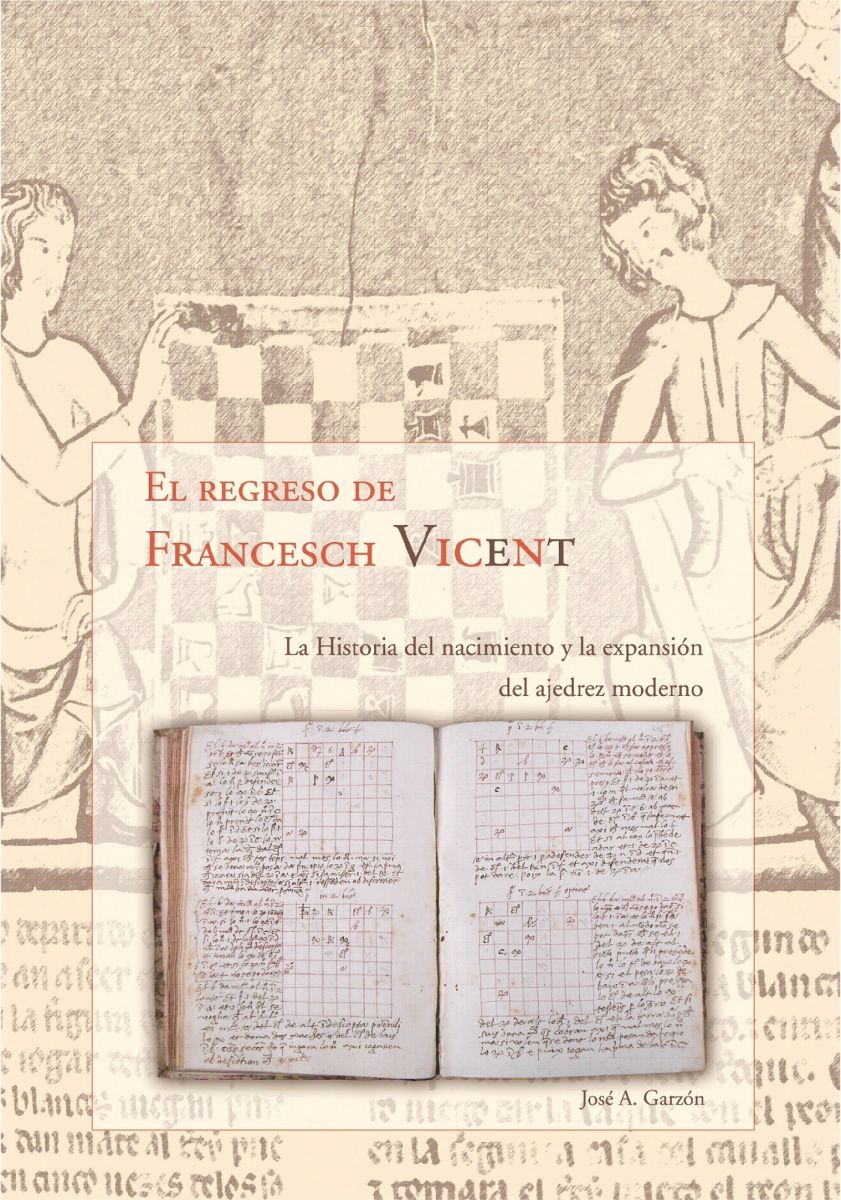Partners

AVERBAKH, Yuri. “Zagadka utrachennoy khigi”, Nauka i Zhizn (Science and Life), Moscow 1985, pp. 137-141. The article was translated into Spanish as “The mystery of the lost book”, International Chess Journal, No. 65, February 1993, pp. 40.
AVERBACH, Yuri. “How to catch a black cat in a dark room”, International Chess Journal, No. 78, March 1994, pp.42-46.
In a premonitory manner the great Russian historian initiates the claim that Vicent’s book is the earliest treaty on modern chess published in the world, as he establishes that the treatises of Lucena and Damiano derive from the work printed in Valencia in 1495. 20 years later research by Garzón on the Cesena manuscript was to show how right he was.
CALVO, Ricardo. El poema Scachs d´amor (siglo XV). Primer texto conservado sobre ajedrez moderno. Madrid: Jaque Siglo XXI, Madrid 1999. ISBN: 84-923279-3-6.
GARZON ROGER, José Antonio. En pos del incunable perdido. Francesch Vicent: Llibre dels jochs partitis dels schachs, Valencia, 1495. Valencia: Biblioteca Valenciana, Colección Bibliofilia, 2001. This work can be accessed from the Valencia Digital Library (Biblioteca Valenciana Digital, BIVALDI): bv2.gva.es. ISBN:84-482-2860-X.
|
Garzón definitively establishes Vicent’s book as the first published on modern chess. Although much progress had been made in the field of chess history as far as knowledge of the contents of the book was concerned thanks to the studies of Averbakh, in a strictly bibliographical field the very publishing of the book was doubted. News of the Montserrat copy as early as 1783, the visit to the abbey of Vargas Ponce in 1799 who actually held the book in his hands (and lingered over the chess diagrams), and the sale of 30 copies in January 1496 prove not only the publishing of the book but also its contents. Finally, Garzón documents a sale of the book in Barcelona in 1913, which gives new hope of its future discovery. In short, we are given 4 independent pieces of evidence as to the book’s publication, its primacy, its content, and even its current existence. |
 |
GARZÓN, José A. El regreso de Francesch Vicent. La Historia del nacimiento y la expansión del ajedrez moderno. Valencia: Fundación Jaume II el Just, Generalitat Valenciana, 2005. ISBN: 84-482-4193-2.
 |
The author takes on the commitment of proving the Valencian origin of modern chess so as to universally satisfy specialists on a matter that could not be settled in the 19th and 20th centuries. |
GARZÓN, José A. The Return of Francesch Vicent. The History of the Birth and Expansion of Modern Chess. Valencia: Fundación Jaume II el Just, Generalitat Valenciana, 2006. ISBN: 84-482-4194-0.
|
A great personal effort by the author and publisher has resulted in the English translation of Garzón’s book so as make his research available to specialists in general. The fine translation by Manuel Pérez Carballo does justice to the subject. |
 |
GARZÓN, José A. Estudio del tratado ajedrecístico de Luca Pacioli. Valencia: Pentagraf Impresores, 2007.
 |
This monograph provides a detailed study of the chess treatise by the noted Renaissance mathematician Luca Pacioli (c. 1445-1517), which was rediscovered in 2006 in the Library of the Palazzo Coronini Cronberg Foundation in Gorizia, Italy. |
GARZÓN, José A. Luces sobre el Ingenio, el pionero libro del juego llamado marro de punta, de Juan Timoneda. Valencia: Universidad Nacional de Educación a Distancia (the Spanish Open University) Colección Interciencias, 2010. ISBN: 978-84-92885-008.
|
This piece of research features significant novelties, of which the two most important should be singled out:
|
 |
PALUZÍE Y LUCENA, José. “Notice sur un Manuscrit en langue catalane existant à l´Archive du Palau à Barcelone”. La Stratégie, París, 4th April 1912, pp. 121-123.
PALUZÍE Y LUCENA, José. Manual de Ajedrez. Barcelona, 1912, pp. 254-257.
WESTERVELD, Govert; GARZÓN, José A. La reina Isabel la Católica: su reflejo en la dama poderosa de Valencia, cuna del ajedrez moderno y origen del juego de damas. Generalitat Valenciana, Valencia, 2004. ISBN: 84-482-3718-8.
|
The exhaustive research of Westerveld proposed convincingly that it is the grande dame of Spanish history, Queen Isabel the Catholic, who inspired the powerful piece of the small board. He also refers to the connection between the origin of modern chess and the creation of a new game, marro de punta (draughts); he documents both events in Valencia. José A. Garzón has collaborated in several passages of the work and in the writing of 3 chapters and the epilogue. Both authors devote a chapter to the study of the Scachs d´amor with significant novelties and give the date of the poem as 1475 [Link to the article by J. Garzón, Vienna 2010]. |
 |






